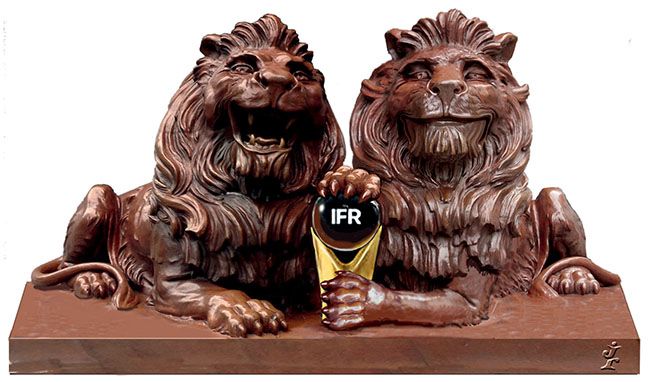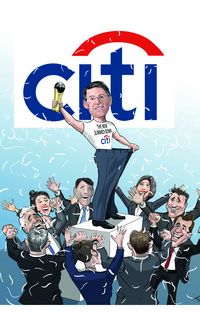Special events
For landing starring positions on the biggest global cross-border acquisition loans of the year and playing a leading role in Asia’s booming outbound M&A as China flexed its financial firepower, HSBC is IFR’s Loan House and Asia-Pacific Loan House of the Year.
2016 was full of surprises, with the shock Brexit vote in the UK and the US presidential elections taking centre stage. The ensuing volatility made underwriting slow-moving loan syndications a nerve-racking affair, but HSBC was able to cross all three regions and assemble syndicates on some of the year’s most high-profile multi-regional deals.
“We had more marquee deals than any other bank and the markets helped to elevate our visibility. Mixed acquisition finance across geographies, across the credit spectrum, is what differentiated HSBC in a highly competitive environment,” said Tim Spray, head of loan syndications EMEA, leveraged and acquisition finance.
The bank’s wins in acquisition and leveraged finance outstripped its competitors, due largely to its advantage in Asia as Chinese M&A into Europe and the US of around US$180bn brought a new inter-regional dynamic and interplay to the global loan market, which is typically dominated by the huge US market.
This earned a role in HSBC’s marquee deal of the year that only deep relationships in Asia could deliver – as lead financial adviser on state-owned China National Chemical Corp’s proposed SFr43bn (US$42.35bn) acquisition of Swiss seeds and pesticides company Syngenta.
HSBC’s balance sheet was crucial to the deal, but it used its resources selectively, providing a sole underwriting commitment and then syndicating a US$20.2bn non-recourse facility that complemented a US$12.7bn Chinese-led bridge facility for ChemChina.
This success followed the bank’s “pivot to Asia” strategy in 2015, which gave a hint of what was to come as the bank shifted a chunk of its assets to more profitable areas such as China and shed costs and jobs.
Syngenta was a true global deal and its syndication spanned all three regions. The deal was syndicated from Europe and HSBC was able to deliver its Asian relationship banks at the ChemChina level, as well as American banks via their European operations.
“Asia to Europe is a core strength of the bank. If you think about Syngenta and ChemChina, we are able to deliver better than anyone else due to our deep relationships in Asia that we can translate into mandates in Europe,” said Richard Jackson, global head of leveraged and acquisition finance.
The bank also bagged top spots on two of the other biggest deals of the year, a US$33.75bn acquisition financing backing Teva Pharmaceuticals Industries’ US$40.5bn purchase of Allergan’s generics business, and a US$56.9bn bridge loan backing German drug and crop chemical group Bayer’s US$66bn takeover of US seed company Monsanto.
This success came against a changing internal backdrop in addition to the drama of external events. HSBC continued to bolster its investment bank with key hires, including Matthew Westerman, who joined from Goldman Sachs in February to co-head an enlarged global banking operation with Robin Phillips.
HSBC’s focus on corporate clients was increased with a reorganisation of its global banking and markets division that includes the transfer of several hundred of the bank’s largest clients from HSBC’s commercial banking division.
The division’s banking arm including client coverage was merged with its capital financing arm that includes debt and equity capital markets and acquisition financing.
HSBC’s balance sheet has always been its major advantage, but these strategic changes are moving its lending operation to the next level with a more proactive approach, allowing teams to generate ideas to take to clients about what is possible around capital structures.
“We finessed sector coverage and brought in senior people who have made changes and helped us to refocus on the right clients with the right intensity in a super-fast paced and tough environment. This put us in or around any situation with a chance of happening,” said James Horsburgh, managing director, capital financing, global banking and markets at HSBC.
EMEA shines
In a down year for the loan market in EMEA, market competition hit new highs and all banks were hunting major trades. HSBC built on the strong performance that earned it IFR’s EMEA Loan House in 2015 by adding big landmark transactions with a global flavour.
“In Europe, we’ve been active in M&A and flow. We’ve held our own and taken market share,” Jackson said.
The bank was one of six underwriters on Bayer’s US$56.9bn bridge loan in an elite group that also included Bank of America Merrill Lynch, Credit Suisse, Goldman Sachs and JP Morgan.
Bayer is a well-banked company that HSBC had known for some time, which left the bank well positioned to be in the top tier, a position that was clinched by its ability to mobilise its large balance sheet and deliver quickly in size.
The financing, which was the third biggest global syndicated loan ever, was sold down to 26 of Bayer’s core relationship banks with a 40% oversubscription.
Determined push
A determined push in leveraged lending ushered in closer co-operation between coverage and syndication teams on both sides of the Atlantic and collaboration across borders and groups stepped up as the year progressed.
Information-sharing is helping the bank’s drive in its EMEA leveraged finance franchise with the sponsor client coverage, sponsor finance and leveraged loan teams sitting together.
“In Europe, the highlight is leverage. We’ve really stepped it up. We’ve been pushing for a while with sponsors and corporates and now we’re in a spot where they’re comfortable that HSBC will execute and get the right outcome,” Jackson said.
HSBC’s focus on leverage required close collaboration and cooperation across borders and groups, particularly with its growing US operation on deals such as Platform Specialty Chemicals’ US$1.35bn cross-border senior secured Term Loan B refinancing in November.
That deal, which earned HSBC a left lead arranging position on the €700m tranche, highlighted the repricing wave that swept through the transatlantic markets from the middle of 2016.
The deal showed the bank’s ability to execute in a tight timeframe and the result exceeded expectations as strong technicals in Europe and an oversubscription on the euro tranche allowed an increase and tighter repricing of the US dollar tranche.
HSBC’s integrated US leveraged credit platform is moving up the league tables along with its high-yield bond operation as its US corporate and flow business continues to build. The bank also picked up market share in Asia with a strong focus on event financing, although not at the expense of its core flow business.
China’s Tencent Holdings also turned to HSBC – this time alongside other banks – for a US$3.5bn non-recourse loan backing its purchase of a majority stake in Finnish mobile games developer Supercell. HSBC was one of the seven leads on the deal, which attracted 17 other lenders.
“2016 finally saw the acquisition finance deal count explode, and HSBC was at the forefront of the market, leading a significant proportion of the key transactions across Asia-Pacific,” said Phil Lipton, head of loan syndications in Asia-Pacific.
US-Asia co-operation was a feature of the bank’s sole MLA and bookrunner role in the A$465m (US$346m) acquisition facilities that supported Hannesbrands’ A$1.1bn purchase of Pacific Brands that gave the company an Asia-Pacific foothold and an opportunity to develop its global manufacturing operations.
HSBC used its global execution and distribution platform in Sydney, New York and Hong Kong to provide an Australian dollar financing that was syndicated in Australia and Asia.
To see the digital version of this review, please click here.
To purchase printed copies or a PDF of this review, please email gloria.balbastro@tr.com



